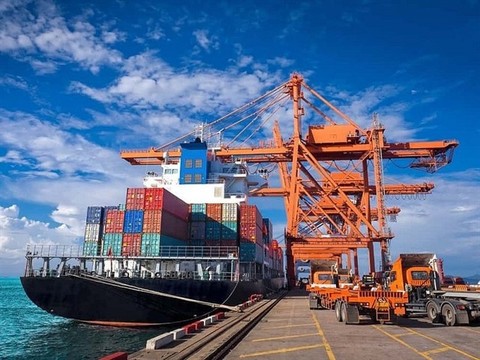
Goods are loaded for export at a port in HCM City. There remain limitations related to origin and non-tariff barriers that have caused many opportunities from FTAs not to be fully utilised. — Photo baochinhphu.vn
Though free trade agreements (FTA) have so far helped Việt Nam boost exports significantly, domestic enterprises need to further study markets and better focus on the country’s strengths to optimise the deals.
According to statistics from the Ministry of Industry and Trade (MIT), since joining the first FTA with ASEAN more than 30 years ago, Việt Nam has so far signed and implemented 16 FTAs while negotiating another three FTAs.
Việt Nam is also the only country that has signed FTAs with all major economic partners globally such as the US, Japan, China, the EU, the UK, and Russia.
The FTAs have opened up many doors for Vietnamese products to enter potential markets, including many demanding markets with high requirements and standards.
Expert Doãn Hữu Tuệ said FTAs helped Việt Nam significantly increase export output, with a growth rate of more than 20 per cent, much higher than the general export growth rate. In 2022, Việt Nam's trade surplus with FTA markets was more than US$30 billion.
Dominik Meichle, chairman of the European Chamber of Commerce in Vietnam (Eurocharm), said with the EU-Vietnam Free Trade Agreement (EVFTA) alone, Việt Nam's export turnover to the EU market increased to more than 48 billion euros in 2023 from about 35 billion euros in 2019.
Hindrance
The signing and implementation of the FTAs have brought many positive export impacts for Việt Nam, but there remain limitations related to origin and non-tariff barriers that have meant many opportunities have not been fully exploited.
According to experts, the certificate of origin (C/O) plays an increasingly important role as a ‘golden key’ to help Vietnamese businesses expand exports and take advantage of tariff incentives under FTAs.
However, the Vietnam Import-Export Report 2023 recently published by MIT shows Việt Nam’s total export turnover which used preferential C/O types under the FTAs in 2023 reached $86.1 billion, accounting for 37.35 per cent of the country’s $230.5 billion total to the FTA markets.
Nguyễn Thường Lạng, PhD, from the National Economics University’s Institute of International Trade and Economics, cited MIT’s data as saying that for the EVFTA alone, after three years of implementation, Vietnamese enterprises could only take advantage of 26 per cent of the agreement's incentives while the rate for FDI-based Việt Nam enterprises was significantly greater.
Specifically, FDI disbursement in Việt Nam hit a record high of more than $23 billion in 2023, most of which headed into the export sector to take advantage of FTA opportunities. More than 70 per cent of Việt Nam's export turnover was a result of FDI enterprises.
As for FTAs, Vietnamese exporters had mainly focused on traditional products with low labour cost advantages, such as textiles-garments and assembled industrial goods and natural resource advantages such as agricultural products and wooden products. Furthermore, these products had not yet been fully exploited through the increase of added value by using supply chain and professional marketing development.
Meanwhile, the fields which associate with the development of international investment relations in the new stage, have remained moderate, not commensurate with the great potential of the economy and mainly implemented by transnational companies, according to the International Investment Research Institute (ISC).
Việt Nam, Lạng said, was optimistically forecast to be the base for manufacturing electronic products worldwide after a series of FTAs take effect. However, this role was unlikely to be played by Vietnamese enterprises in the short term. FTAs had not been used to create enough momentum to form a wave of innovation in domestic businesses.
According to a recent report submitted to the Prime Minister on the results of implementing the CPTPP, EVFTA and UKVFTA, though exports to large FTA markets, such as the EU, CPTPP and the UK, are growing positively, their proportion is still relatively modest and the preferential utilisation rate has not met expectations.
The preferential utilisation rate in the new CPTPP, EVFTA and UKVFTA is about 5 per cent, 26 per cent and nearly 24 per cent, respectively. Meanwhile, FDI enterprises still account for the majority of Việt Nam's key product export turnover, the report notes.
Vietnamese businesses, Tuệ said, had only participated in some stages of the supply chain. The ability to meet and comply with quality, food hygiene, safety and technical requirements of Vietnamese goods was still limited, especially in the context that many import markets had increasingly improved technical standards and non-tariff barriers. Vietnamese enterprises still mainly made processed products according to orders so the added value was not high.
Solutions
To optimise the FTAs, Vietnamese businesses needed to take advantage of market opportunities, participate in the global value chain and access modern technology, according to Lạng.
The first and biggest impact of FTAs is to maximise market expansion in both width and depth. Therefore, to effectively exploit this, domestic businesses need to proactively invest in surveying and understanding the market to firmly grasp the needs of partners. They should actively take part in trade fairs, exhibitions, forums, conferences, trade connections to find suitable partners.
Participation in FTAs means the connection and deep penetration in the global value chain. To gain a genuine connection, domestic businesses need to meet origin standards as committed in each FTA. They absolutely do not cheat on origin or avoid trade defence measures to avoid a loss of credibility with relevant entities.
Most Vietnamese businesses are small and medium sized, so it is difficult for them to cover the entire large market, create scale advantages and invest in high technology, besides being easily dominated by competitors. Therefore, the businesses need to proactively connect and cooperate with each other to increase support and complement each other to enhance the capacity to meet large-scale orders.
Domestic businesses need to invest in research, development and innovation, which create differentiating factors, know-how and core competitive advantages for them. — VNS